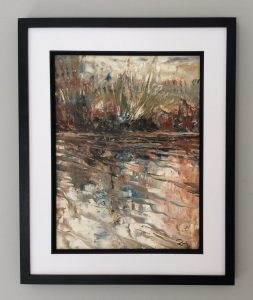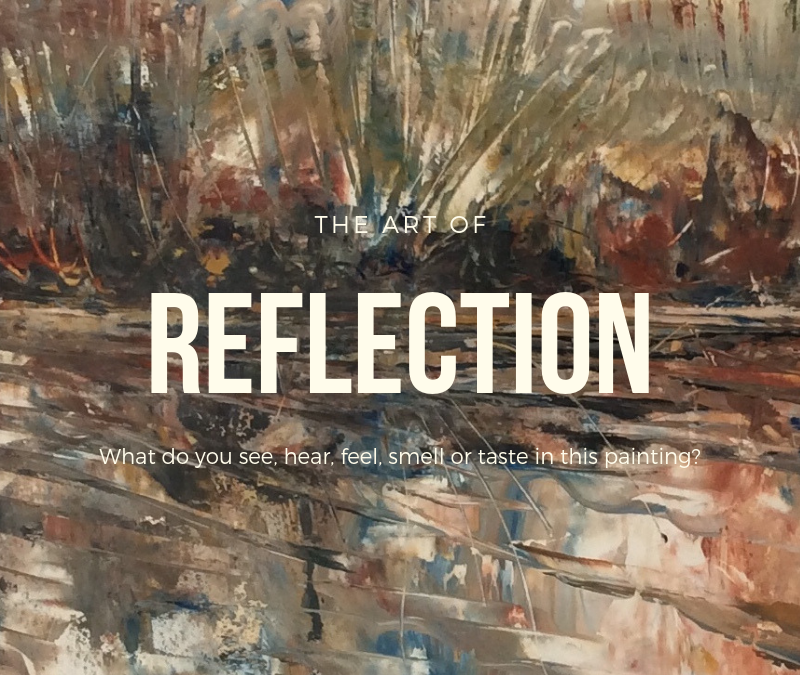Reflecting on our professional practice as part of our ongoing experiential learning is seen as an essential and critical skill to develop, but how well do we actually do it? In this short piece I would like to share two things, firstly my personal confessional experience of perhaps not being as good at reflective practice as I thought I was, and secondly to float the idea that using an arts-based approach can make us better at it.
Today I’m preparing a talk for a corporate client to explore professional reflective practice with their senior management team. As usual I intend to use an arts-based approach, showing them an abstract oil painting to demonstrate that other people’s views of a shared experience doesn’t necessarily have to match our own, in fact they rarely do and we need to be careful not to make wrong assumptions. I call the painting ‘Alternative Perspectives’ and when I painted it seven years ago it provided me with an shocking opportunity to reflect on my own assumptions.
It was Friday afternoon back in 2012 in the business school of Sunderland University where I was working as a senior lecturer and I was searching without luck for some inspiration on how to present my arts-based research ideas to the professional doctorate class the following Monday. The insight was found in a series of huge drawings of the Northumberland coast by a faculty colleague, in an impromptu exhibition of his fine art graduation work. In an empty classroom he carefully unrolled the paper sketches onto the only surface big enough to accommodate them, the floor. The new carpet of massive and dramatic images floating in a sea of charcoal was moving me aesthetically, and my creative inspiration was further fuelled by the artist’s passionate and reflective explanation of how he himself was inspired to create them. Later back in the office, whilst packing up for the weekend and in deep conversation about the drawings and the use of artefacts, I confided in a colleague that rather than prepare a presentation on the subject of reflective practice for the class on Monday I felt more inspired to get my paints out when I got home and to paint a picture. My colleague responded with a professorial challenge; “if you do paint a picture, you could bring it to class on Monday and use it for your presentation, that would be different.” The theme for my presentation and the medium I would use was decided in that moment.
Back home, I prepared my makeshift studio and focused purely on reflection, both as a topic and an image, then after a short series of painterly splashes and scrapes with a palette knife my abstract image was created (See image below).

Alternative Perspectives
It was a frenzy of activity, painting, framing and hanging of the painting on my sitting room wall. Now was the time for me to be an academic and reflect on my newly created artefact. After a couple of cups of tea and a round of buttered toast, I had quickly and fully analysed the image. I could see the gentle ripples of the pond that represented my life, the equally gentle noise of the bulrushes rustling in the wind on the far bank symbolising my natural growth and flexibility, seen in the reflective surface of my life. This process of analysis could be described as a dissection followed by articulation, or the reconstruction of the image. I was on an academic navel-gazing roll and content with my evaluation I immediately started mentally preparing my rippling pond speech for Monday. Then my son Alex came into the sitting room and threw a huge boulder into my pond shattering my reflective illusions. “That looks great Dad!” he said admiringly of my painting “I really like the way the mountains explode into the sky”. “WHAT?” I said, but before he had time to answer I realised in an instant that I had committed the cardinal sin of creative thinking and problem solving, single-loop thinking. My so called artistic mind was not thinking creatively at all. My logical left-brain had taken over and looked for the first things it could find to logically fit the brief. It didn’t even have to be an exact fit, reflections = water = life = nature = plausible metaphor, then all my brain had left to do was use all its intellect and intelligence to reinforce and defend this stand-point. I had accepted the first plausible explanation and closed my mind to alternatives, such as Alex’s wider perspective across a sea with the distant volcanic mountains erupting into the sky. I am not saying that my first thoughts were right or wrong, or that Alex’s perspective was more right or wrong, what I have realised in this critical incident is firstly that in reflective practice we must not close our minds after the first explanation is found that fits, or nearly fits. It is crucial for full reflection to open our minds to more alternatives, which will ultimately facilitate more informed findings. Secondly, I have realised that in the symbolic interpretation of an artefact, the denotations, connotations and higher-order levels of signification of the associations brought to mind through the artefact can mean completely different things when viewed by the artist who created it and by another observer who cannot possibly share the same cultural knowledge. Indeed when presented in the class the following Monday there was much debate around whether the image was inspired by a Tuscany or Northumbrian landscape. To one student it represented a battle field. Everyone had their own perspective and they argued to support it. Alex’s exploding mountains observation has exploded some of my personal assumptions about my so-called creative thinking and reflective practice.
As I look at the painting now as I write this I continue to see different things, metaphors appropriate to how I think and feel today. Metaphors I will use with the corporate delegates as I advise them to avoid jumping to conclusions to quickly, opting for the first explanation that fits or nearly fits, and that they must critically challenge their own assumptions, perceptions and perhaps even create their own paintings, drawings, sculptures or other creative artefacts to help them adopt and learn from alternative perspectives.
Why not try it yourself, and let me know how you get on.


Recent Comments